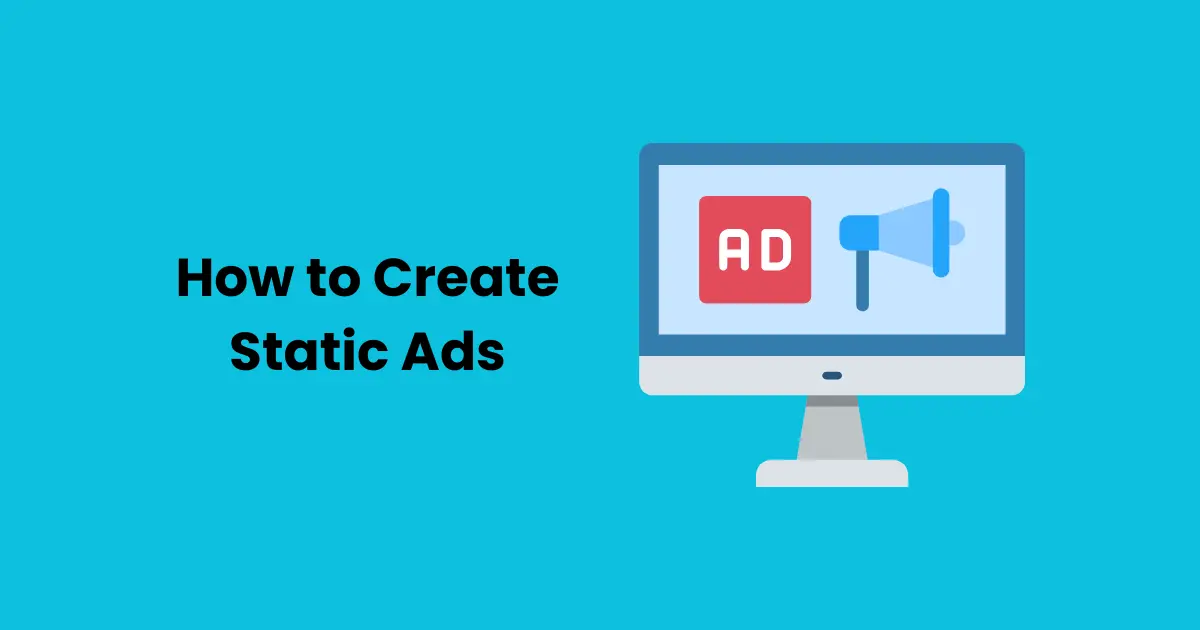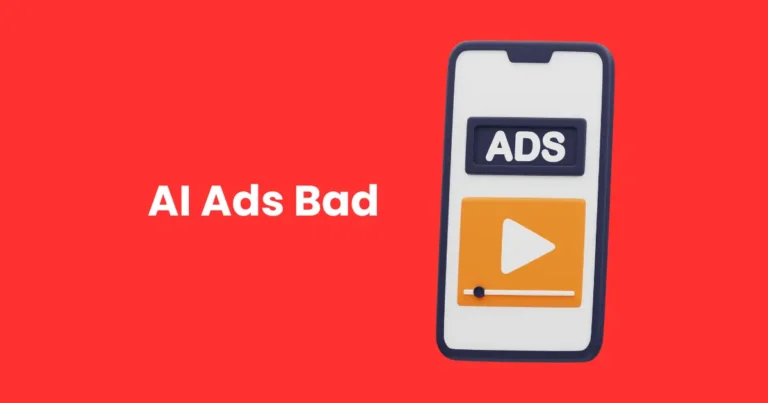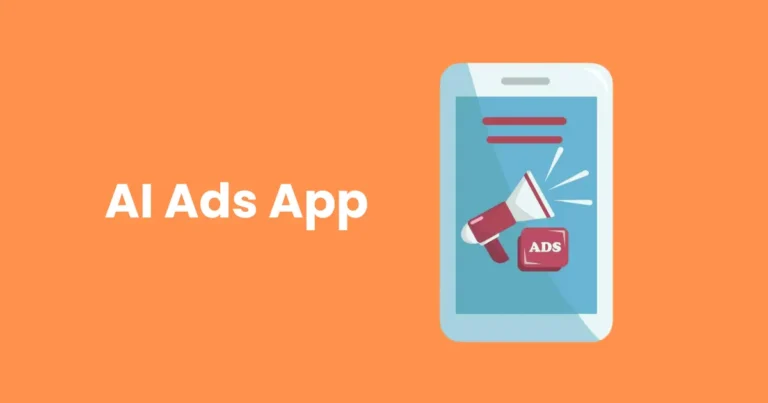How to Create Static Ads | Best Practices for Creating Static Ads

Contents
- 1 Essential Elements of a Static Ad
- 2 1. A Compelling Headline
- 3 Step-by-Step Guide on How to Create Static Ads
- 4 Tools for Designing Static Ads
- 5 Best Practices for Creating Static Ads
- 5.1 1. Keep It Simple
- 5.2 2. Prioritize Visual Hierarchy
- 5.3 3. Use High-Quality Images
- 5.4 4. Make the CTA Stand Out
- 5.5 5. Leverage Brand Identity
- 5.6 6. Optimize for Platforms
- 5.7 7. Choose Contrasting Colors
- 5.8 8. Test Different Variations
- 5.9 9. Focus on the Benefits
- 5.10 10. Avoid Overuse of Text
- 5.11 11. Use Analytics to Improve
- 5.12 12. Stay Aligned with Your Audience
- 6 Common Mistakes to Avoid When Creating Static Ads
- 6.1 1. Overloading the Design with Too Much Text
- 6.2 2. Ignoring Platform Guidelines
- 6.3 3. Neglecting the Call-to-Action (CTA)
- 6.4 4. Using Low-Quality Images
- 6.5 5. Overcomplicating the Design
- 6.6 6. Forgetting About Mobile Optimization
- 6.7 7. Lack of Consistent Branding
- 6.8 8. Ignoring Target Audience Preferences
- 6.9 9. Poor Contrast and Readability
- 6.10 10. Failing to Test Ad Variations
- 6.11 11. Misleading or Overpromising
- 6.12 12. Overlooking the Importance of Analytics
- 6.13 Conclusion
Static ads are visually compelling, non-moving image advertisements designed to convey a clear and concise message to your audience. These ads are a powerful tool for marketers because they combine high-quality visuals, impactful text, and strong branding to attract attention and encourage engagement. If you’re curious about how to create static ads that stand out in today’s competitive digital landscape, this guide provides a step-by-step approach to crafting ads that resonate with your target audience. By focusing on simplicity, creativity, and effective messaging, static ads can become a key component of your marketing strategy.
Why Choose Static Ads?
Static ads offer a simple yet highly effective way to communicate with your audience. Unlike animated or video ads, they rely on a single, visually appealing image to deliver a strong message. Here are some compelling reasons to choose static ads:
- Cost-Effective
Creating static ads is more budget-friendly compared to producing videos or animations. Small businesses and marketers with limited resources can design impactful static ads without incurring high costs. - Faster Load Times
Static ads load quickly, ensuring they are displayed seamlessly, even in areas with slower internet connections. This improves the user experience and reduces the risk of viewers skipping or ignoring your ad. - Simplicity and Clarity
Static ads focus on delivering one clear message. This simplicity makes them easy to understand and more likely to grab attention in a cluttered digital environment. - Versatility Across Platforms
Whether it’s social media, websites, or display networks, static ads are compatible with a wide range of platforms. Their versatility allows you to target diverse audiences effectively. - Consistency in Branding
Static ads allow you to maintain consistency in your branding. With consistent colors, fonts, and logos, you can strengthen brand recognition and build trust with your audience.
If you’re looking to maximize your advertising efforts, learning how to create static ads can help you craft visually appealing and impactful campaigns that drive engagement and conversions.
Essential Elements of a Static Ad
Creating an effective static ad requires careful attention to key components that ensure your message resonates with the audience. By incorporating these essential elements, you can make your static ads both eye-catching and impactful:

1. A Compelling Headline
The headline is the first thing your audience notices. It should be concise, attention-grabbing, and relevant to your target audience. Use power words or phrases that spark curiosity, such as “Exclusive Offer” or “Limited Time Deal.”
2. High-Quality Visuals
Strong visuals are the backbone of a successful static ad. Use high-resolution images or graphics that align with your message and brand identity. Avoid cluttered designs and ensure that the visuals complement the text rather than overpowering it.
3. Concise and Clear Copy
The text in a static ad should communicate the message clearly and quickly. Focus on delivering value by highlighting benefits, addressing pain points, or emphasizing a unique selling proposition (USP). Brevity is key—stick to one or two short sentences.
4. Branding Elements
Incorporate your brand’s logo, color scheme, and typography into the design. Consistent branding helps improve recognition and builds trust with your audience. Make sure your branding is subtle yet noticeable.
5. Attention-Grabbing Call-to-Action (CTA)
A static ad without a clear call-to-action is incomplete. Encourage the viewer to take immediate action with phrases like:
- “Shop Now”
- “Get Started”
- “Learn More”
Place the CTA prominently, ensuring it stands out from the rest of the ad.
6. Balanced Layout
A well-balanced layout is crucial for readability and visual appeal. Use a hierarchy of design elements to guide the viewer’s eye, starting with the headline, followed by the visuals, and ending with the CTA.
7. Proper Color Contrast
Choose colors that not only align with your brand but also ensure readability. High contrast between text and background enhances visibility and draws attention to key information.
8. Platform-Specific Dimensions
Static ads must adhere to the dimension requirements of different platforms. For instance:
- Instagram: 1080 x 1080 pixels (square format)
- Facebook: 1200 x 628 pixels (landscape format)
Optimizing dimensions ensures your ad looks professional and performs well across platforms.
By combining these elements effectively, you can create static ads that are visually appealing, easy to understand, and capable of driving engagement. When done right, static ads become a powerful tool in capturing attention and converting viewers into customers.
Step-by-Step Guide on How to Create Static Ads
Creating impactful static ads involves a structured process to ensure they resonate with your audience and achieve your marketing goals. Follow these steps to learn how to create static ads effectively:

1. Define Your Target Audience
Start by identifying the audience you want to reach. Understand their:
- Demographics: Age, gender, location, etc.
- Interests: What they enjoy or value.
- Behavior: Online habits and purchasing patterns.
Knowing your audience helps you craft a message that appeals to their needs and desires.
2. Choose the Right Platform
Each platform has unique features and audience expectations. Pick one based on your marketing goals:
- Instagram: Focus on visually engaging and creative content.
- Facebook: Great for ads with text-heavy visuals and CTAs.
- Google Display Network: Ideal for reaching a broad audience through websites and apps.
Research the platform’s ad format requirements to ensure compatibility.
3. Craft a Clear and Compelling Message
Your message is the heart of the ad. Focus on:
- Highlighting benefits or solutions.
- Using simple, concise language.
- Including persuasive elements, such as discounts or exclusivity.
For example, instead of saying, “Our product is great,” say, “Save 50% and transform your mornings with our premium coffee!”
4. Select Eye-Catching Visuals
Visuals should instantly capture attention. To achieve this:
- Use high-resolution images or custom illustrations.
- Maintain alignment with your brand’s color palette and design.
- Avoid clutter—ensure visuals enhance, not distract from, your message.
Tools like Canva, Adobe Express, or Crello can help you create professional visuals easily.
5. Use an Attention-Grabbing Call-to-Action (CTA)
Your ad should inspire the audience to act. Use actionable and urgent phrases like:
- “Shop the Sale Now”
- “Join Today and Save 20%”
Place the CTA prominently in the design, ensuring it’s impossible to miss.
6. Optimize Ad Dimensions
Each platform has specific dimension requirements for static ads. For example:
- Instagram: 1080 x 1080 pixels (square format).
- Google Display Ads: 300 x 250 pixels (rectangle format).
Using the correct dimensions prevents distortion and ensures a polished appearance.
7. Test Multiple Ad Variations
Creating different versions of your static ad allows you to:
- Test various headlines, visuals, and CTAs.
- Analyze which design performs best.
Platforms like Facebook Ads Manager enable A/B testing for easy comparison.
8. Analyze and Optimize Performance
After running your ad, monitor its performance using analytics tools. Evaluate metrics such as:
- Click-through rate (CTR).
- Impressions.
- Conversion rate.
Use this data to tweak your designs and messaging for better results in future campaigns.
By following these steps, you’ll learn how to create static ads that not only look professional but also engage your target audience and drive measurable outcomes. Static ads, when executed thoughtfully, can become a cornerstone of your marketing strategy.
Tools for Designing Static Ads
Designing effective static ads doesn’t require advanced technical skills thanks to the availability of user-friendly tools. These platforms offer various features to help you create professional and visually appealing ads. Here are some of the best tools to consider when learning how to create static ads:

1. Canva
Best For: Beginners and professionals looking for easy-to-use templates.
- Canva is a highly versatile tool with drag-and-drop functionality.
- It offers a wide range of templates tailored for static ads across platforms like Instagram, Facebook, and Google Ads.
- Features like text effects, icons, and customizable elements make it perfect for creating polished ads quickly.
2. Adobe Photoshop
Best For: Advanced designers who need complete creative control.
- Adobe Photoshop provides unmatched flexibility for creating custom static ads from scratch.
- Its powerful editing tools allow for advanced color correction, layering, and typography.
- Ideal for designers who want to create highly unique and professional designs.
3. Adobe Express (formerly Adobe Spark)
Best For: Quick and simple ad designs with branding options.
- Adobe Express provides pre-designed templates that are easy to customize.
- It’s great for small businesses looking to create branded ads without a steep learning curve.
- The tool integrates seamlessly with Adobe Creative Cloud for additional flexibility.
4. Figma
Best For: Collaborative ad design projects.
- Figma is a cloud-based design tool perfect for team collaboration.
- It allows real-time editing and feedback, making it ideal for group projects.
- Features like vector editing and prototyping ensure high-quality designs.
5. Crello (now VistaCreate)
Best For: Quick and creative ad designs.
- Crello offers an extensive library of templates for social media ads, banners, and other formats.
- It includes pre-made animations, though it also supports static ad creation.
- A beginner-friendly tool with drag-and-drop editing and royalty-free assets.
6. Pixlr
Best For: Lightweight, browser-based editing.
- Pixlr is a free, web-based photo editing tool with advanced features like layering and retouching.
- It’s perfect for designing static ads without downloading heavy software.
- Offers templates and easy export options for multiple platforms.
7. Snappa
Best For: Marketers looking for quick ad creation.
- Snappa is an intuitive design tool with pre-sized templates for platforms like Facebook, Instagram, and LinkedIn.
- It includes a vast library of stock images, graphics, and fonts to simplify the design process.
8. GIMP (GNU Image Manipulation Program)
Best For: Designers looking for a free, open-source alternative to Photoshop.
- GIMP provides advanced editing tools for creating professional-looking static ads.
- Its customizable interface makes it a powerful option for those familiar with photo editing.
9. PicMonkey
Best For: Beginners who want stylish designs with minimal effort.
- PicMonkey provides user-friendly tools for adding text, graphics, and effects to your ad designs.
- It’s ideal for creating ads that require vibrant, eye-catching visuals.
10. Google Web Designer
Best For: Creating display ads for Google Ads campaigns.
- Google Web Designer offers templates specifically optimized for Google Ads.
- Although it’s more commonly used for interactive ads, you can design static ads as well.
- Includes built-in tools to ensure compatibility with Google’s display network.
Key Features to Look for in a Design Tool
When selecting a tool to create static ads, consider the following:
- Ease of Use: Look for tools that match your skill level.
- Template Library: Pre-designed templates save time and effort.
- Customization Options: Ensure the tool allows for full control over colors, fonts, and layouts.
- Export Formats: Check for compatibility with platforms (e.g., PNG, JPEG, or PDF).
- Cost: Some tools are free, while others require a subscription. Choose based on your budget.
Best Practices for Creating Static Ads
Creating static ads that stand out and deliver results requires strategic planning and attention to detail. Here are the best practices to follow when learning how to create static ads that are both visually appealing and effective in driving engagement:

1. Keep It Simple
Simplicity is key in static ad design. Overloading the ad with too much text or too many elements can confuse the viewer. Focus on one main message or goal per ad to maintain clarity.
- Use minimal text to communicate your message.
- Avoid clutter by leaving ample white space.
2. Prioritize Visual Hierarchy
Guide the viewer’s attention by using a clear visual hierarchy. Arrange the elements so the audience sees the most important details first.
- Start with a bold, attention-grabbing headline.
- Position the visuals in a way that complements the headline.
- Place the call-to-action (CTA) prominently at the end.
3. Use High-Quality Images
Low-resolution images can make your ad look unprofessional. Always use high-quality visuals that align with your brand and message.
- Use professional photos or vector graphics.
- Optimize image quality for the platform you’re targeting.
4. Make the CTA Stand Out
Your call-to-action (CTA) is the driving force behind your ad’s effectiveness. Ensure it’s easy to see and encourages immediate action.
- Use vibrant colors to make the CTA pop.
- Keep the CTA text actionable and specific, e.g., “Sign Up Today” or “Buy Now.”
5. Leverage Brand Identity
Incorporate your branding elements, such as your logo, colors, and typography, to ensure consistency and build recognition.
- Stick to your brand’s style guide for a cohesive look.
- Place the logo in a visible but non-distracting location.
6. Optimize for Platforms
Different platforms have unique requirements for ad dimensions and formats. Ensure your static ads are optimized for the platform you’re targeting.
- Use square dimensions (e.g., 1080 x 1080 pixels) for Instagram.
- Use landscape formats (e.g., 1200 x 628 pixels) for Facebook.
- Check platform guidelines to avoid cropping or distortion.
7. Choose Contrasting Colors
Color contrast is crucial for readability and visual impact. Ensure that the text stands out against the background and draws attention to key elements.
- Use complementary colors to enhance visibility.
- Avoid overly bright or clashing color schemes.
8. Test Different Variations
A/B testing allows you to understand what works best for your audience. Experiment with variations in:
- Headlines and copy.
- Visuals and color schemes.
- CTA placement and wording.
Analyze performance metrics to optimize your ad design further.
9. Focus on the Benefits
Rather than listing features, emphasize the benefits your product or service offers. Show how it can solve a problem or improve the user’s life.
For example:
- Instead of “Our software has multiple tools,” say “Save time and boost productivity with our all-in-one software.”
10. Avoid Overuse of Text
Most platforms recommend keeping text to a minimum for better engagement. If you must use text, ensure it’s concise and easy to read.
- Use large, legible fonts.
- Highlight keywords or phrases to draw attention.
11. Use Analytics to Improve
After running your static ads, analyze their performance using platform analytics. Evaluate metrics like:
- Click-through rates (CTR).
- Impressions and engagement.
- Conversion rates.
Use the insights to refine your strategy and improve future ads.
12. Stay Aligned with Your Audience
Always design with your target audience in mind. Tailor your visuals, copy, and overall style to resonate with their preferences and expectations.
By adhering to these best practices, you can ensure your static ads are not only visually appealing but also effective in capturing attention and driving action. When you master how to create static ads with these principles, you’ll boost your chances of achieving your marketing goals.
Common Mistakes to Avoid When Creating Static Ads
When learning how to create static ads, it’s just as important to understand what not to do. Avoiding common mistakes can significantly improve the quality and effectiveness of your ads. Here are the most frequent errors and tips on how to steer clear of them:
1. Overloading the Design with Too Much Text
One of the most common mistakes in static ads is cramming too much text into the design. This overwhelms the audience and dilutes the message.
How to Avoid:
- Stick to concise and impactful messaging.
- Use visuals to communicate ideas rather than relying solely on words.
2. Ignoring Platform Guidelines
Different platforms have specific size and format requirements for ads. Ignoring these guidelines can lead to cropped images, distorted layouts, or reduced visibility.
How to Avoid:
- Always check the recommended dimensions for each platform.
- Use templates or design tools that automatically size ads correctly.
3. Neglecting the Call-to-Action (CTA)
A weak or missing CTA can make your ad ineffective. The audience needs clear direction on what to do next.
How to Avoid:
- Include a clear, action-oriented CTA like “Shop Now,” “Learn More,” or “Sign Up Today.”
- Use contrasting colors and bold fonts to make the CTA stand out.
4. Using Low-Quality Images
Low-resolution or pixelated visuals make your ad look unprofessional and untrustworthy.
How to Avoid:
- Always use high-resolution images or vector graphics.
- Optimize images for web use without compromising quality.
5. Overcomplicating the Design
Adding too many elements like colors, fonts, or graphics can create a cluttered and distracting ad.
How to Avoid:
- Stick to a clean and minimalist design.
- Use no more than two fonts and a cohesive color scheme.
6. Forgetting About Mobile Optimization
Many ads are viewed on mobile devices, yet some designers only focus on desktop layouts.
How to Avoid:
- Test your ad designs on both mobile and desktop screens.
- Ensure text is legible, and key elements are visible on smaller screens.
7. Lack of Consistent Branding
Inconsistent use of branding elements, such as logos, fonts, and colors, can confuse your audience and weaken brand recognition.
How to Avoid:
- Follow your brand’s style guide in every ad.
- Place your logo in a prominent but non-intrusive location.
8. Ignoring Target Audience Preferences
Designing without considering the preferences, behaviors, and needs of your target audience often results in irrelevant or ineffective ads.
How to Avoid:
- Research your audience’s demographics, interests, and online behavior.
- Tailor the design, tone, and message to align with their preferences.
9. Poor Contrast and Readability
Using colors or fonts that blend into the background can make your ad difficult to read and reduce its effectiveness.
How to Avoid:
- Use high-contrast color combinations to improve visibility.
- Opt for simple, legible fonts in appropriate sizes.
10. Failing to Test Ad Variations
Relying on a single ad design without testing alternatives can limit your ability to identify what resonates best with your audience.
How to Avoid:
- Create multiple versions of your ad with slight variations in design, messaging, or CTA.
- Use A/B testing to determine which version performs better.
11. Misleading or Overpromising
Misleading visuals or exaggerated claims may attract clicks but lead to dissatisfaction and harm your brand’s reputation.
How to Avoid:
- Ensure the ad’s message is honest and accurately reflects your product or service.
- Avoid clickbait tactics that don’t deliver on promises.
12. Overlooking the Importance of Analytics
Launching ads without monitoring their performance can result in wasted time and resources.
How to Avoid:
- Track key metrics like impressions, click-through rates, and conversions.
- Use insights from analytics to optimize your future campaigns.
By avoiding these mistakes, you can create static ads that are more engaging, professional, and effective. When you implement these tips while mastering how to create static ads, you’ll maximize your chances of reaching and resonating with your audience.
Conclusion
Creating static ads that are visually appealing and effective in achieving marketing goals requires careful planning, creativity, and attention to detail. By understanding how to create static ads, you can craft designs that not only grab attention but also deliver your message clearly and encourage action.
From selecting the right tools and following best practices to avoiding common mistakes, each step in the process is vital. Focus on keeping your designs simple, maintaining brand consistency, and tailoring your ads to your target audience’s preferences. Incorporating high-quality visuals, compelling CTAs, and optimized designs for various platforms will further enhance the performance of your ads.
Remember, the key to success lies in continuous improvement. Use A/B testing and analytics to refine your approach and create ads that resonate with your audience. With the right strategies, your static ads can become powerful assets in your marketing campaigns.






